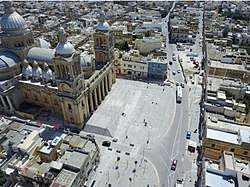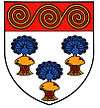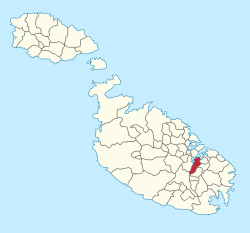Paola, Malta
Paola (Maltese: Raħal Ġdid, Italian: Casal Nuovo, both meaning "New Town") is a town in the South Eastern Region of Malta, with a population of 7,864 people (March 2014).[1] Paola is renowned for the Ħal Saflieni Hypogeum, its large parish church (the biggest church in the Maltese Islands), its square with shopping centres, the Good Friday procession, and its football club, Hibernians FC. Mariam Al-Batool Mosque, the only mosque in Malta, as well as an Islamic Cultural Centre are found in Paola. The country's correctional facilities and the largest burial grounds, the Addolorata Cemetery are also in this town. The town is a commercial centre in the Southern Harbour area of Malta, about 5 km from the capital Valletta.
Paola Raħal Ġdid Pawla Casal Paola, Casal Nuovo | |
|---|---|
 Paola square and Church of Christ the King | |
 Flag  Coat of arms | |
 | |
| Coordinates: 35°52′22″N 14°30′27″E | |
| Country | |
| Region | South Eastern Region |
| District | Southern Harbour District |
| Founded | 1626 |
| Founded by | Antoine de Paule |
| Borders | Cospicua, Fgura, Luqa, Marsa, Santa Luċija, Tarxien |
| Government | |
| • Mayor | Dominic Grima (PL) |
| Area | |
| • Total | 2.5 km2 (1.0 sq mi) |
| Population (Jan. 2019) | |
| • Total | 8,706 |
| • Density | 3,500/km2 (9,000/sq mi) |
| Demonym(s) | Paolites Pawlist (m), Pawlista (f), Pawlisti (pl) |
| Time zone | UTC+1 (CET) |
| • Summer (DST) | UTC+2 (CEST) |
| Postal code | PLA |
| Dialing code | 356 |
| ISO 3166 code | MT-39 |
| Patron saint | Christ the King; Our Lady of Lourdes |
| Day of festa | 4th Sunday of July; 1st Sunday after 15 August |
| Website | Official website |
It is named after Grand Master Antoine de Paule, who laid the foundation stone in 1626. To encourage migration to Paola, de Paule gave indemnity to the debts of the families who moved there.[2] This account was recorded for the first time by de Solidanis in the eighteenth century. He says that in 1750 the village was not yet a parish on its own (part of Ħal Tarxien).[3] Paola was almost deserted due to a local disease, but became increasingly habitable after intervention by captain Hunn.[4]
There are two parish churches, one dedicated to Christ the King and the other to Our Lady of Lourdes. The feast of Christ the King is celebrated on the fourth Sunday of July and Our Lady of Lourdes is celebrated on the first Sunday after 17 August. The parish also has a Franciscan church dedicated to Saint Anthony, in the Għajn Dwieli zone of the parish. St. Ubaldesca Church is the oldest church in Paola and was the first parish church there. In 2008 the church underwent minimal restoration.[5] Villa Perellos, which is dedicated to the homonymous grand master, is a landmark of historical importance for the locality.[6]
History
Prehistory
Although Paola was founded in the 17th century, several megalithic remains have been found within the locality.
The Hypogeum

The Hypogeum has been designated a UNESCO World Heritage Site. The Hypogeum is a large complex of rooms hewn out of the limestone about 11 metres (36 ft) below the surface. It appears to have been used as a burial site, and also as a temple. Neolithic man carved out the Hypogeum using only antlers and stone picks as tools, and in semi darkness. The Hypogeum is made up of three levels, which are superimposed upon each other. The upper level resembles the earlier rock-cut tombs found elsewhere on the Islands. The middle level, hewn out during the temple period (3800 - 2500 B.C.) is made up of numerous chambers. Many statuettes, amulets, figurines and vases were recovered here. The most famous figurine is that of the so-called Sleeping Lady, a reclining figurine, perhaps meant as a representation of eternal sleep. It is on display at the National Museum of Archaeology, Valletta
Kordin Temples
The Kordin Temples were located on a high plain that overlooks the Grand Harbour:
- Kordin I – The temple was excavated in part by A.A. Caruana, and later by Sir Themistocles Zammit in 1908 and finished by T. Ashby and T.E. Peet in 1909. It was poorly preserved and consisted of small and irregular rooms. Kordin I was left open to the elements. Bombings during the Second World War and construction on the site have obliterated all of the remains.
- Kordin II – The temple was first investigated by Cesare Vassallo in 1840. A.A. Caruana started to excavate the site properly in 1892. The excavation was continued by Albert Mayer in 1901 and finished by Ashby and Peet in their campaign of 1908–9. The chronology was difficult to figure out, and whether all of the building could be dated to the temple period is debatable. Kordin II must have been in use during the entire temple period since pottery throughout this period's phases were found during its excavation. Kordin II was damaged by the air bombardments of the Second World War and the new buildings that were constructed since.
- Kordin III – This is the only temple on Kordin still in existence today, and it is of the standard Ġgantija-phase 3-apse design. It is the only temple whose forecourt, which is in front of the concave façade, has a stone pavement, as is the entrance passage leading to the central court. Behind the temple and contemporary with it, are small rooms possibly used for storerooms or the like, or even an irregular, lobed minor temple. One of the most noted feature of Kordin III is the 2.75-metre-long 'trough' lying across the entrance to the left apse. It has seven deep transverse grooves produced by grinding. It is made of hard limestone brought from over 2 kilometres away so it is highly probable that it is for grinding corn (a multiple quern) and contemporary with the temple rather than for grinding 'deffun', the traditional Maltese roofing material, which would make it considerably more recent. Kordin III is in a walled area next to the Church of St. Anthony and is kept locked to give it maximum protection.[7]
Other
Several other remains from pre-history to classic antiquity remain in Paola.[8]
Order of St. John
Antoine de Paule was appointed Grand Master of the Order of St. John on 10 March 1623, when he was 71 years old. On 20 July 1626, to address a growing population, he set up a new town on the hill known as Tal-Għerien (literally: of the caves)[9] which was named Casal Nuovo (meaning: new town) since it was funded during the rule of the Order. The town was later named Casal Paola to bear the family name of the Grand Master. To present date, the town is still referred to by this name. The town's coat of arms originally consisted of a white and red octagonal cross contrasted against a white and red background. During the Military Order, the town became the spiritual successor of the neighbouring town Tarxien and still depended for military tactics by the Chief of Army of Zejtun.[10] During his rule, De Paule built a church in the town, dedicated to St. Ubaldesca who was a Sister of the Order of St. John, and this church was the first parish church of the town.[9]
Pope Urbanus VIII issued a Bull that gave permission for this church to be built. This Papal Bull was issued from the Basilica of Santa Maria Maggiore in Rome on 31 July 1629. An extract from this Bull reads as follows: "we accept this request and to the afore mentioned Antonius, with the Apostolic authority granted by this Bull, we give the authority that in the mentioned town in a location of his preference, as long as it is comfortable and just, a church can be built in honour of the afore-mentioned Saint." On 12 November 1629, the Council of the Order of St. John decided to effect what was written on the Bull. The laying of the first foundation stone of this church was celebrated in grand style by Grand Master de Paule himself on Sunday 25 August 1630.[11]
"On the day of Sunday, the 25th day of the month of August 1630, which is the feast of the king Saint Ludovico, the Most Serene and the Most Revered Grand Master Fra Antoine de Paule went to the town, which for the past four years had taken the name of his family and which was established in the land of Marsa, and he was accompanied by numerous Venerable Gran Cruci as well as by numerous brethren from our Order and in front of a crowd of people he laid the first stone of the church which was to be built for the grace of God and the Holy Virgin Ubaldesca, sister of our Religion, with the permission of the Most Reverend Prior of the church, Fra Salvatur Imbroll, who was adorned with pontifical clothes and according to the rites of the Holy Roman Church. This was done with the apolostic authority given by the Magnificent His Holiness from Santa Maria Maggiore in Rome, on the 3ist of July 1629 and which was written in the public deed of the Notary Lorenzo Grima."[11][12] The church was enlarged in 1900 to accommodate the growing population of Paola and it became a parish in 1910, when it was dedicated to the Sacred Heart of Jesus. A new and larger church, the one dedicated to Christ the King, was eventually built to replace it in Antoine de Paule Square, the town's main square. Since then, the church has undergone restoration and its interior is adorned with gold guilding and a niche holding the parish's titular statue of Christ the King.
Demographics

Band clubs
- Soċjeta' Filarmonika 11 ta' Frar- Madonna ta' Lourdes
- De Paule Philarmonic Society Christ the King Band (Is-Soċjetà Filarmonika De Paule Banda Kristu Re) (tal-Ħomor)
- Christ the King Band Club (Ghaqda Socjali w Muzikali Kristu Sultan Banda Paola) (tal-Ħodor)
- Lourdes Philarmonic Society A.D. 2007 (Is-Soċjetà Filarmonika Lourdes A.D. 2007)
Zones in Paola
- Għajn Dwieli
- Il-Qortin
- Kordin (Corradino)
- Moll il-Faħam
- L-Ordinanza
- Ras Ħanżir
- Tal-Borġ
- Tax-Xewk
Paola main roads
- Pjazza Antone De Paule (Paola Square)
- Telgħat Raħal Ġdid (Paola Hill)
- Triq Bormla (Cospicua Road)
- Triq Għajn Dwieli (Għajn Dwieli Road)
- Triq Ħal Luqa (Luqa Road)
- Triq Ħal Tarxien (Tarxien Road)
- Triq Ħaż-Żabbar (Żabbar Road)
- Vjal Kristu Re (Christ the King Avenue) - formerly called Triq il-Belt Valletta (Valletta Road)[13]
- Triq il-Perit Dom Mintoff (Dom Mintoff Road) - formerly called Triq Kordin (Corradino Road)[14]
- Triq l-Isqof Buhagiar (Bishop Buhagiar Street)
- Triq Sammat (Sammat Street)
- Vjal Santa Luċija (Santa Lucia Avenue)
- Vjal Sir Pawlu Boffa (Sir Paul Boffa Avenue)
- Triq Palma (Palm Str)
- Triq l-Arkata (Arcade Street)
Notable people
- Sir Paul Boffa (1890–1962), Prime Minister, resided in this locality
- Ino Bonello, international movie art director
- Chris Fearne, paediatric surgeon and Parliamentary secretary for Health
- Immanuel Mifsud, author, winner of the European Union Prize for Literature in 2011
References
- "Estimated Population by Locality 31st March, 2014". Government of Malta. 16 May 2014. Archived from the original on 21 June 2015.
- Cassar Pullicino, Joseph (October–December 1949). "The Order of St. John in Maltese folk-memory" (PDF). Scientia. 15 (4): 163. Archived from the original (PDF) on 17 April 2016.
- http://melitensiawth.com/incoming/Index/Scientia%20(Malta)/Scientia.%2015(1949)4(Oct.-Dec.)/01.pdf p. 174.
- MacGill, Thomas (1839), "A handbook, or guide, for strangers visiting Malta", p.131.
- "Archived copy". Archived from the original on 4 March 2016. Retrieved 17 August 2015.CS1 maint: archived copy as title (link)
- "Palazzo crying out for restoration". Times of Malta. 27 April 2016.
- Columbia-Lippincott Gazetteer, 1952 Edition. p. 1425.
- "Read and expand" (PDF). melitensiawth.com. Retrieved 13 April 2018.
- "Tal-Għerien",
- Ferris, Achille (1881). Memorie dell'inclito Ordine gerosolimitano esistenti nelle isole di Malta. Malta: C. Busuttil. p. 31.
- "The Church dedicated to St. Ubaldesca". Socjeta de Paule. 22 April 2016. Archived from the original on 18 October 2003.
- Abela, Giovanni Francesco (1647). Della Descrizione di Malta Isola nel Mare Siciliano con le sue Antichità, ed Altre Notizie (in Italian). Paolo Bonacota. p. 94.
- "MINUTI Laqgħa tal-Kunsill Lokali Paola" (PDF). Local Government.
- "Corradino Road becomes Dom Mintoff Road, Gaddafi Gardens renamed". Times of Malta. 30 March 2016. Retrieved 30 March 2016.
- "Twinning". localgovernment.gov.mt. Government of Malta. Retrieved 18 September 2019.
External links
| Wikimedia Commons has media related to Paola, Malta. |